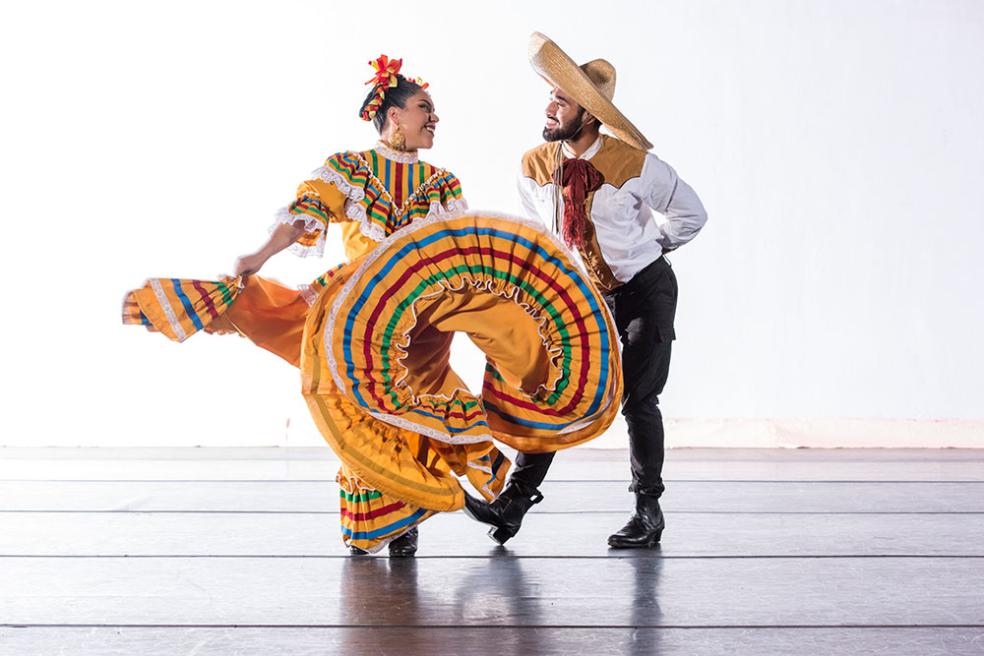
The performances are from March 1-3 in Gist Hall Theatre. Featuring 35 student dancers and Mariachi musicians, “Fiesta Folklórica” weaves together the sights and sounds of Mexico’s diverse cultural dances, ancient traditions, and mariachis.
Directed by Linda Maxwell and Jacqueline Silva, students will perform Azteca and Mexican folkloric dances, along with mariachi music. The “Fiesta Folklórica” Concert is funded in part by a grant from the Office of Diversity, Equity, and Inclusion at Cal Poly Humboldt, which made it possible to bring in Horacio Heredia to teach Folklorico dance from Sinaloa; Ramon Ramirez, Bertha Winddancer, and Milagros Alston to instruct a Danza Azteca workshop; and Jessie Vallejo to present a mariachi workshop at the University.
Tickets are $10 for general admission, $5 for children and seniors, and free for Cal Poly Humboldt students with ID. Tickets may be purchased at the door or in advance at centerarts.humboldt.edu.
The concert opens with a sampling of the elements of a Danza Azteca ceremony, invoking sights and sounds of ancient Tenochtitlan with colorful regalia and stirring music.
Interludes of mariachi music between the dancing will include smooth trumpet and violin melodies, infectious guitarrón, vihuela and guitar rhythms, and heart-filled vocal melodies, as members of Mariachi de Humboldt present well-loved rancheras, son huastecos, cumbias, and traditional mariachi marches.
Dances from Nayarit feature the everyday themes of working, courting, and drinking, reflected in the lively movement of the brightly colored, swirling skirts and the clashing of the machetes. The dancers are inspired to shout symbolic “gritos” or cries of joy, which blend with the spirited music of the mariachi characteristic of central Mexico. Students will perform the dances San Pedreño (San Pedro), El Buey (The Ox), El Son Del Coamecate, and Los Bules (The Bull). Choreography is by retired faculty member Jeff O’Connor, inspired by the original choreography by Ramón Morones.
The word "Sinaloa" is from the indigenous peoples of the region and means pitaya, a common local fruit traditionally grown in this state. The traditional vestario features off-the-shoulder necklines made of flower-patterned cotton with lace, ruffles, and ribbons. Historically, the flower-patterned sections featured popular products from Sinaloa. The footwork is strong enough to work with the traditional Sinaloa music, which includes brass, woodwinds, and percussion instruments. This region is choreographed by Linda Maxwell, with one dance by guest artist Horacio Heredia.
The Yucatán peninsula juts off the southern part of Mexico into the Gulf of Mexico. Its geographical location made it one of the ports of entry for Spanish ships, and thus, the dances acculturated some of the Spanish movements like raised arms with fingers snapping to simulate castanets, the lifted body carriage, and the great use of the “zapateado.” Dances from Yucatán include Mi Yucateca, Las Canastas de Halachó, Las Cintas, Las Mujeres Que Se Pintan, and El Chinito Koy Koy. Choreography is by retired faculty member Jeff O’Connor and Jacqueline Silva.
The state of Jalisco is the home of the songs and dances of Guadalajara, a city well known for its beautiful people, mariachis, and elaborate fiestas. The lyrics and the movements of the songs and dances depict country life in general and often use imagery of the courtships of the animals as a metaphor for the relationships of the people. The themes are of love, humor, and tragedy, and thus tell the story of a colonized people who thrive and contribute immeasurably to life as we know it in the Americas. This group of dances is among the most popular in Jalisco's repertoire. The climax of these is Jarabe Tapatío, the Mexican National Dance. Other dances include Charreada and El Cihualteco, all choreographed by Jacqueline Silva.
Fiesta Folklorico runs from Friday to Sunday, March 1-3, 2023. Friday and Saturday shows commence at 7 p.m., and Sunday’s show begins at 2 p.m. in Gist Hall Theatre.